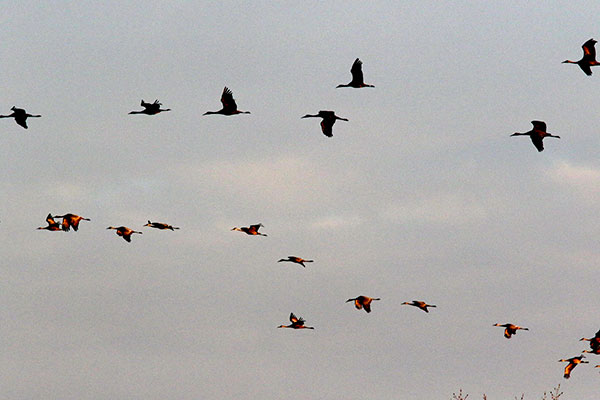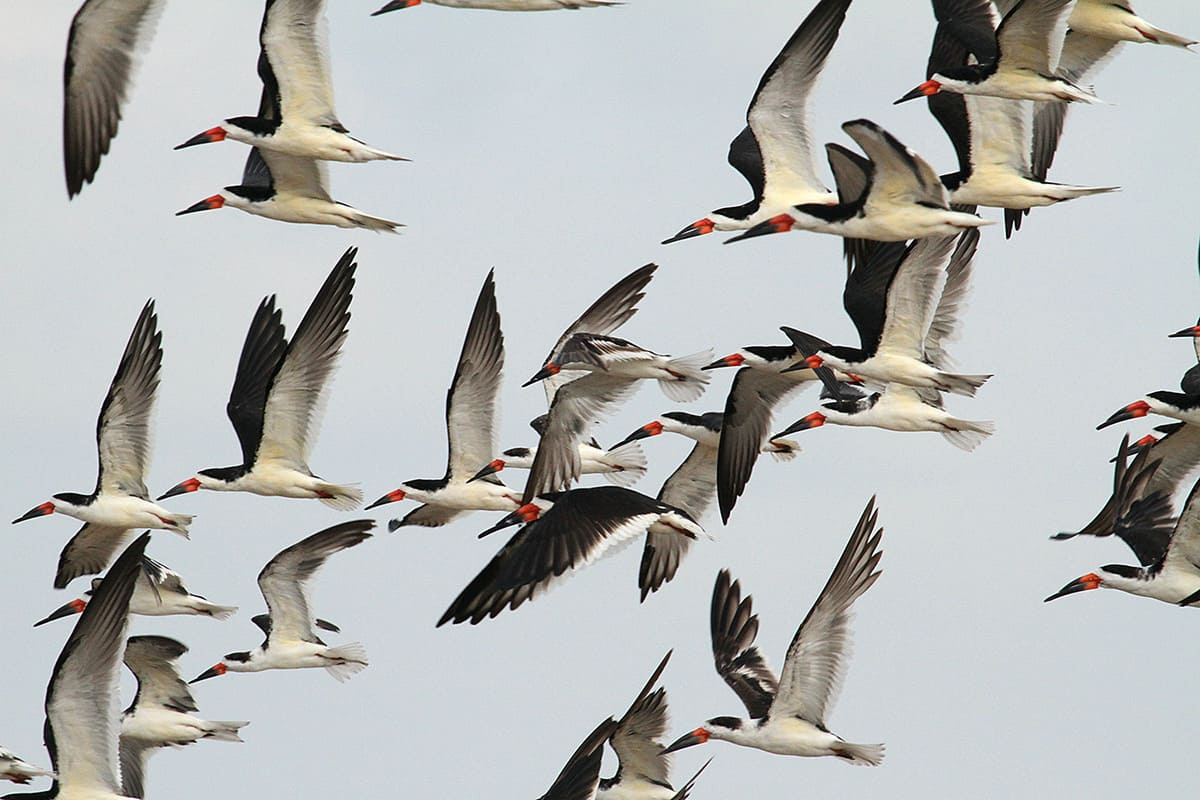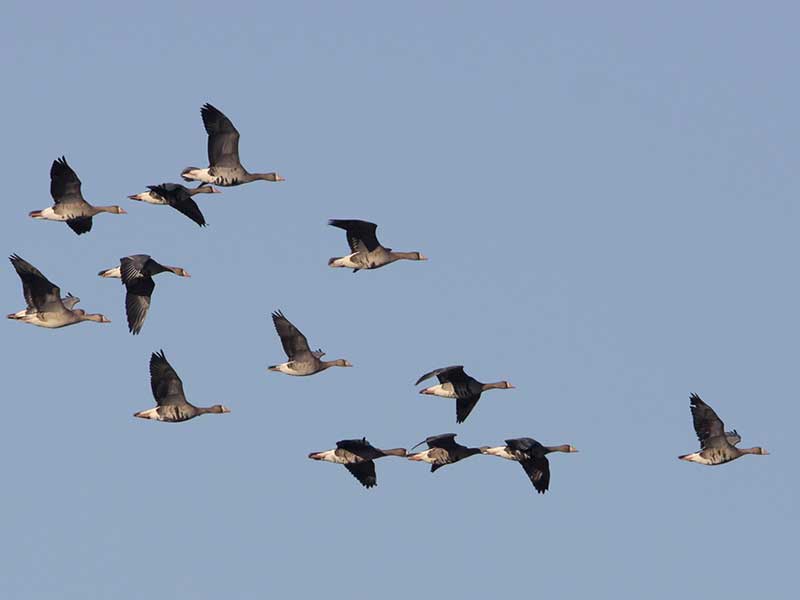
Groups of birds have different names. Not so long ago, someone (re)discovered that a group of crows is called “a murder.”
This curious collective noun caught fire on the internet.
Once people also found out that a group of owls is called “parliament,” a mini-craze over the collective bird nouns for birds erupted.
It turned out that there are hundreds of collective bird names for various species, each seemingly weirder than the next.
What’s the thing with strange group bird names? Where do the collective bird nouns originate from, and how important are they for science? Should we memorize them?
On this page
The Origin of Collective Bird Nouns
Language is a living thing.
It changes and evolves along with societies. Vocabulary can reveal many things about the age at which certain terms have originated.
The internet has the “power” to revive many forgotten aspects of human history and language and give them a chance to get re-embedded into our consciousness.

Book of Saint Albans (Image credits: Wikipedia.org)
The origin of the picturesque group bird names seems to lie in the crosssection of courtly hunting, aristocratic whit, folk wisdom, and wordy English poetry of the Middle Ages and beyond.
All of these influences melted down into a 15th-century phenomenon called “Terms of Venery.”
What Are The Terms of Venery?
The “terms of venery” are a specific language phenomenon – a set of archaic collective nouns that originally described groups of animals, birds included. The lengthy set of phrases was made up and used by noble hunters to address the groups of animals they stalked, but they got more popular and outgrew their original purpose.
In time, the Terms of Venery archaic database of collective nouns grew to include pretty much everything else.
Why did the hunters need a unique vocabulary?
Hunters supposedly had the intrinsic motivation to give distinct names to groups of animals they hunted.
However, aristocrat hunters had an additional motive – to have a vocabulary that would distinguish them from ordinary people and yeomen and give them a specific noblemen-hunting identity.
The specialized vocabulary that the noblemen used in hunting was called “terms of venery.” As James Lane from Babble.com puts it, “Terms of venery were the linguistic equivalent of silly hats: colorful, affected, fashionable, and very popular.” A linguistic decadence of a sort.
As noted before, the weird collective names fashion trend extended to creatures and objects of all kinds, becoming separate from hunting. For example, it is hardly plausible that courtly hunting included stalking girls and boys – creatures who apparently exist in groups called “giggles” and “blushes,” respectively.
All of these imaginative terms might have been forgotten if it weren’t for The Book of Saint Albans (original: Boke of Seynt Albans) about various things that would interest gentlemen of that time. Published in 1486, the book was one of the early examples of English printing and has allowed the Terms of Venery to be preserved into the modern age.
Is There Any Science to Terms Of Venery?
It is important to note that there isn’t a scientific base for any of these names (scientific naming of animals peaked about two centuries later).
This witty Think Big article divides the Terms of Venery into three types: clever (“a charm of hummingbirds”), obvious (“a paddling of ducks”), and pretentious (“an ostentation of peacocks” – although I would call these “an attempt in sounding poetic”).
If you ask me for a personal opinion, I conclude that the Middle Ages aristocrats, poets, and men of letters simply got the kick out of imagining unusual collective nouns. There was no “higher purpose” except having fun and, perhaps, looking smart (highly questionable from today’s point of view)
It is important to note that there isn’t a scientific base for any of these names
As for deeper historical conclusions, investing that much energy in silly word hats sort of hints that this bunch had it quite easy in life, doesn’t it?
Popular Names For Groups of Birds
Let’s explore some of the most popular archaic bird names today.

Photograph © Mark Crowe.
Why is a group of crows called a ‘Murder’?
Like many other collective nouns for groups of birds, “A Murder of Crows” can be traced back to 15th-century England.
Crows and ravens are scavengers and opportunistic predators. They often fly circling around a carcass on the ground – including human carcasses on battlefields. It is assumed that they also landed there to feed and probably, well, help the wounded (die). They would act the same way around our precious cattle and sheep herds.
Why is a group of ravens called ‘Unkindness’?
Raven flocks suffered a similar fate as crow flocks. Nobody knows for sure where the term “unkindness of ravens” came from. However, it is certainly based on a similar sinister perception. In folklore, ravens are associated with bad luck, illness, and death. In mythology, they are often shown as trickster creatures.
From a scientific point of view, the term ‘unkindness’ is very inadequate because, socially, ravens are all but unkind. They are gentle and loving parents and partners who are kind to each other. Also, removing disease-spreading carcasses from the environment is an un-deliberately kind gesture to other creatures that could get sick – including humans.
Why is a group of owls called a parliament?
Owls have been associated with wisdom and intelligence since Antique times. After all, the owl is a mythological companion and a symbol of Athens, the Greek goddess of wisdom.
Learn more: Top 10 Fun Owl Facts
Thus, it was logical to assign a group of owls an esteemed collective name such as parliament (although, ironically, owls look way wiser and more competent than most of the human faces in the parliaments around the world today).
Why is a group of geese called a gaggle?
A collective noun for a group of geese is a gaggle, and it comes from the fact that geese tend to get quite loud, and they, well, gaggle when they’re together. So, this group name belongs to the obvious/folk wisdom cluster.

Flock of Greater White-fronted Geese
Why is a group of larks called ascension?
Larks are a pretty stark example of how varying these names can be.
Ascension of larks is a term with murky origins, and it is unclear if it is a true collective noun. We know for sure that the English poet George Meredith wrote a short poem called “The Lark Ascending” at the end of the 19th century.
However, the poem was about the ascending tones of the skylark song rather than their aggregations. Still, “the ascension of larks” somehow stuck as a collective noun.
“Ascension” as a name for a group of larks is entirely unexpected, as the term is generally connected to spiritual experiences. The term was interesting enough to be used as a title for the novel “Ascension of Larks.”
Other sources note that the collective lark noun is an exaltation. The notable book on collective nouns is called the same – “An Exaltation of Larks.”
The theory is that larks and their songs evoke a happy feeling in people, and they are perceived as happy birds. Thus, they were given such exhilarating names.
However, there is only one species of lark living in the United States – the Horned Lark.
Other Examples of Collective Nouns For Groups of Birds
- A group of doves, quails, or swans is called a bevy.
- A group of chickens, hens, or turkeys is called a brood.
- A group of ducks is called a brace.
- A group of finches, goldfinches, or hummingbirds is called a charm (charming they are!)
- A group of eagles, hawks, or other birds of prey is called an aerie.
- A group of cormorants, doves, pigeons, or birds, in general, is called a flight.
- A group of pheasants, grouse, partridges, or quail is called a convey.
Are Strange Group Bird Names Important For Science?
Bird scientists or birders do not use the lively names you’ve seen, except perhaps as a fun conversation-starting factoid over a coffee. Science has no use for them.
There is only one commonly used collective bird name in science: Flock.
There are big flocks, small flocks, migratory flocks, and so on – but there is no scientific need to give a particular name to any of those bird groups.
Bird scientists or birders do not use the lively names you’ve seen
On the other hand, some of these names perpetuate negative stereotypes about certain birds that actually go against science. Remember the crows and the ravens. Their feeding habits might give us goosebumps, but they’re not the only gruesome opportunistic predators of the avian world.
For example, a flock of cute, Great Tits (another interesting name origin story there) will take on a killing spree on occasion – and no one can imagine calling a flock of tits “murder.”
These misleading situations are why some birders think that the archaic collective terms for birds are best forgotten.
However, that doesn’t mean that these names might not be useful in other sciences.
Etymology is a branch of linguistics (the science of language) that studies words’ origins. Diving deep into the meanings of animal names is certainly an interesting niche of etymology.
Multi-disciplinary work in between linguistics and ornithology, such as Gary H. Meiter’s book “Birds is the Word,” analyzes the origins of North American bird names, including the curios group names. Readings like this are a treat for linguists, English teachers, historians, ornithologists, and birders alike.

Group of Buffleheads in flight
The Question of Authenticity
There are so many special names for groups of birds that it is likely impossible to track all of their origins.
As for the names with untraceable sources – there is no guarantee that someone, in the spirit of those idle English aristocrats, simply didn’t make up some of them and added them to the lists. Another reason to avoid wasting too much energy on them (unless it’s your project or passion).
Do I Need To Learn All the Collective Bird Nouns?
That’s a tricky question. It depends on your motivation.
If you want to be a bird scientist, the answer is no – scientists do not use these collective nouns anywhere on the planet. Most of the top bird scientists have never heard of them.
If you are the type of person who thrives on collecting bizarre trivia, then you could find a use for the list above.
However, as Nicholas Lund of The Birdist blog and Audubon Magazine reasonably notices, people are already wasting lots of brainpower on trivia. If you want to impress people with random information or create a unique bar quiz, there are plenty of animal facts that are astounding and based on reality.
For example, did you know these awesome bird facts?
- Owls can turn their head all the way around – almost 360 degrees (a full circle); whoever, their eyes are non-moving.
- Budgerigars are so far the only non-mammalian species observed to be susceptible to the contagious yawning phenomenon.
- Emus have fluffy feathers that split in two; they can soak their plumage when they run into a body of water and thereby avoid dehydration in their arid native Australian habitat.
- Fruit-eating birds like waxwings regularly get drunk on overwintered fermented berries in the spring.
- Cardinals and many other birds practice “anting” – rubbing the feathers with crushed ants or visiting ant nests to provoke formic acid spray attacks. It is unclear why birds engage in anting, but hypotheses include getting rid of external parasites, grooming, easing skin irritation during molting, and sensory self-stimulation.
- Bearded vultures swallow and digest entire bones; they will fly them high and throw them to the ground to break them into pieces.
Conclusion
The number of collective nouns for birds and other animals is impressive. All the “terms of venery” that originated in the Middle ages because aristocratic hunters wanted to have a bit of fun are now an internet curiosity and perhaps a decent and fun conversation starter.
However, in practical and scientific terms, these collective nouns are not particularly useful and may even add to the confusion by pushing some negative stereotypes about birds, such as crows.
Still, collective nouns in the form of Terms of Venery are with us again nonetheless. How much attention we give them is up to us.
